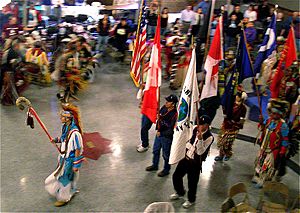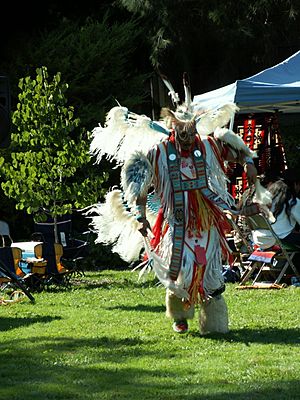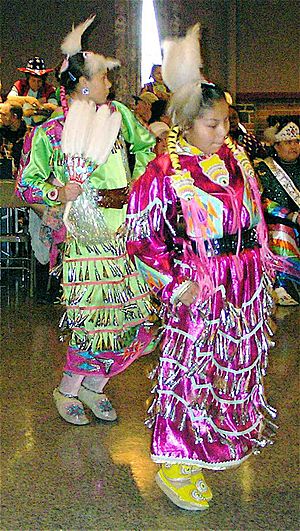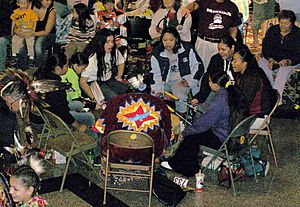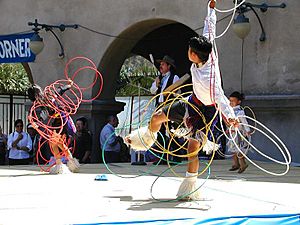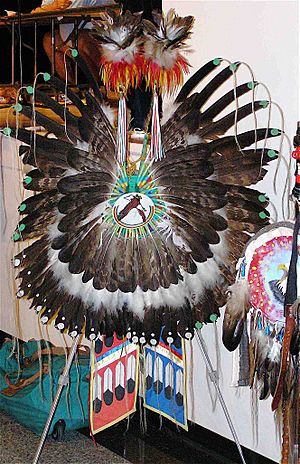Powwow facts for kids
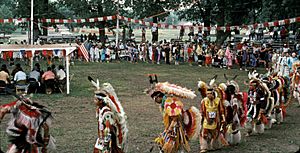
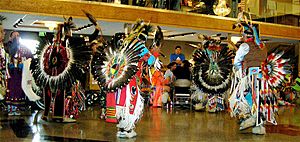
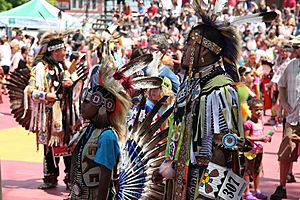
A powwow (also spelled pow wow or pow-wow) is a special gathering for many Native American and First Nations communities. It's a time for people to come together, dance, sing, and celebrate their rich cultures. Powwows can be small and private, or large public events. They can happen indoors or outdoors. Some powwows even have dance competitions where dancers can win prizes! These events can last for just one day or go on for a whole week.
It's important to know that the word "powwow" has a deep meaning for Indigenous people. Sometimes, in old movies or by other groups, the word was used to mean any kind of meeting. However, this is not the correct way to use it, as it doesn't respect the true cultural importance of a powwow.
Contents
The Story of Powwows
The word "powwow" comes from the Narragansett word powwaw. This means "spiritual leader." Public dances similar to today's powwows first became common in the Great Plains region. This was in the late 1800s and early 1900s. During this time, Native American communities faced challenges. Some government rules tried to limit their traditional dances. But many communities bravely kept their cultures alive in secret. By the mid-1900s, powwows were also held in the Great Lakes region.
How Powwows Are Organized
Planning a powwow starts many months before the event. A group called the powwow committee does all the work. They find and hire the main leaders, tell everyone about the event, and find a good place to hold it. They also invite vendors to sell food and crafts. Powwows are often sponsored by tribal groups or Native American communities. Sometimes, a club at a college or university helps. These groups provide money and volunteers.
Powwow Leaders and Performers
The head staff run the powwow during the event. Being chosen for the head staff is a big honor.
- The Powwow Host (MC): The master of ceremonies, or MC, is the voice of the powwow. They tell everyone what's happening, set the schedule, and manage the drum rotation. The MC also tells jokes and runs contests.
- Leading the Dancers: The head dancers are very important. They lead the grand entry, a special parade that starts the powwow. Other dancers usually wait for the head dancers to begin.
- The Heartbeat: Drum Groups: Singers perform while playing the drums. Each powwow has a special host drum that is highly respected. Drum group members are often family or friends. Host drummers lead songs at the start and end of a powwow. Famous host drums include the Black Lodge Singers, Cozad Singers, and Yellowhammer.
Experiencing a Powwow

How a Powwow is Set Up
A powwow is usually set up in large circles. The middle circle is the dance arena. Around it are the MC's table, drum groups, and seating for dancers. Outside these circles is an area for people watching. Further out, you'll find vendor booths selling food, crafts, and regalia supplies.
At outdoor powwows, the main circle is often covered by a tent. This protects everyone from sun or rain. It's very important to keep the drums safe and dry. Most vendors also have their own tents.
Powwow Manners and Respect
Powwows have special rules for behavior, called etiquette. These rules help everyone show respect. For example, dancers' special clothing is called "regalia," not a "costume."
Be polite and respectful. Do not touch or play the drums unless you are part of the drum group. Never touch a dancer or their regalia without asking. Some tribes do not allow photos during their ceremonies. Always check if photography is allowed.
The Grand Entry Ceremony
A powwow session starts with the Grand Entry and a prayer. The Eagle Staff leads, followed by flags and then the dancers. A host drum plays an opening song. This event is sacred. Some powwows do not allow photos or videos during this time.
Military veterans often carry the flags and eagle staffs. Then the head dancers enter. Other dancers follow in a specific order: Men's Traditional, Grass Dance, Fancy, and then Women's Traditional, Jingle, and Fancy. Teens and children follow in the same order. After the Grand Entry, the MC invites a respected community member to give a prayer. Another host drum then plays a Flag Song, followed by a Victory Song. The flags and staffs are placed at the MC's table.
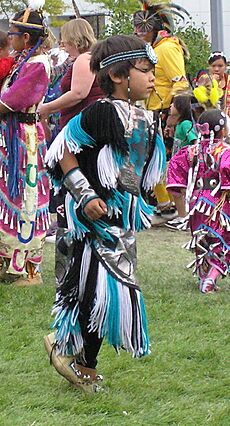
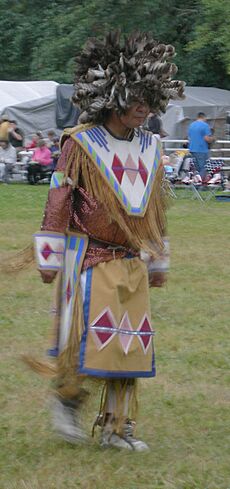
Amazing Powwow Dances
Powwow dance styles come from the traditions of Great Plains nations. The most common dance is the intertribal. During this, any dancer can join in. Other dances include the round dance and "sidestep." Each has a special step, but dancers of any style can participate.
Many powwows have dance contests. Dancers compete in specific styles and age groups for prizes. To compete, dancers must wear the correct regalia. Dance categories can vary by region.
Men's Dance Styles
- Fancy Dance: Bright, colorful regalia with two large feather bustles. Dancers perform dramatic spins and leaps.
- Northern Traditional: Traditional regalia, often with a single eagle feather bustle. Movements tell stories, like a warrior scouting.
- Straight Dance: Neat, handmade regalia. Smooth, controlled steps, tapping the foot to the drum's beat.
- Grass Dance: Regalia with long, flowing fringe, like grass in the wind. Movements are detailed.
- Chicken Dance: Dancers move like a prairie chicken. Regalia is simpler, with a porcupine hair roach.
- Eastern War Dance: A storytelling dance from the East Coast. Men carry a fan and dance stick.
Women's Dance Styles
- Traditional: Traditional regalia of cloth or leather. Dancers perform precise, controlled movements.
- Buckskin and Cloth: Traditional dances from the South, named for dress material.
- Fancy Shawl: Bright colors, long decorated shawl. Dancers perform rapid spins and elaborate steps.
- Jingle Dress: Dress with hundreds of small metal cones that make noise. Dancers use light steps. This is sometimes a healing dance.
- Couples dances: two step and owl dance. Group dances: Snake and Buffalo dance.
- The Gourd Dance is for veterans and their families. The drum is usually in the center of the arena.
The Music of Powwows
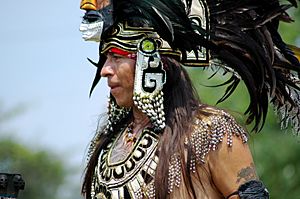
While many tribes have their own unique music styles. But powwow music often blends different traditions. The music of the Plains cultures is very important, as they helped start modern powwows.
The Power of Drumming
"Good drums get the dancers out there, good songs get them to dance well. Without drum groups, there is no music. No music, no dance, no powwow."
Many drum groups might be at a powwow. Each powwow has a special host drum that is highly respected. Drum group members are often family or friends. Groups might be named after families or places. In the past, only men would drum, with women singing harmonies. Since the mid-1970s, women have also joined in drumming. Today, you can see mixed-gender and all-female drum groups. A drum group brings their drum, drumsticks, a drum stand, and chairs. The drums and stands are often decorated. You'll notice "hard beats" in the songs. These are strong drum strikes that mark different parts of the song.
Drum Etiquette and Respect
It's important to think of a drum as a living being. It should be treated with great respect. Drum etiquette is very important.
At Oklahoma powwows, the drum is a main symbol. It sits in the center of the dance floor. Southern drums hang from four posts. Northern drums are usually on the outside of the dance area.
Drummer-singers should stay at their drum, ready to sing. A dancer might ask for a song by whistling or gesturing. It's disrespectful to leave a drum completely alone. Some drum groups prefer that women stand behind the drummers to sing harmonies. When gifts are offered to the drum, musicians stand to show thanks.
The Voices of the Powwow
While the drum is the heart of a powwow, dancers focus on the song's melody. Rhythms, tones, and pitch help them create their dance moves. Many songs use vocables, special sounds like "ya," "hey," and "loi." This is common in intertribal songs. A song usually has four "pushups." A lead singer starts the melody, and another singer joins in. Then the whole group sings. Three "hard beats" mark the end of the chorus and the start of a new verse. The song ends with a "tail," a short finish. Singing styles vary by region. In the North, singers use a high falsetto voice. In the South, a lower voice range is common. Native American singing often uses a pentatonic scale. While some songs use vocables, many also include words from Native languages like Cree and Lakhota.
See also
- Native American hobbyism, Germany
- Neerchokikoo
- Potlatch
- Wild Westing
- Rendezvous (fur trade)


